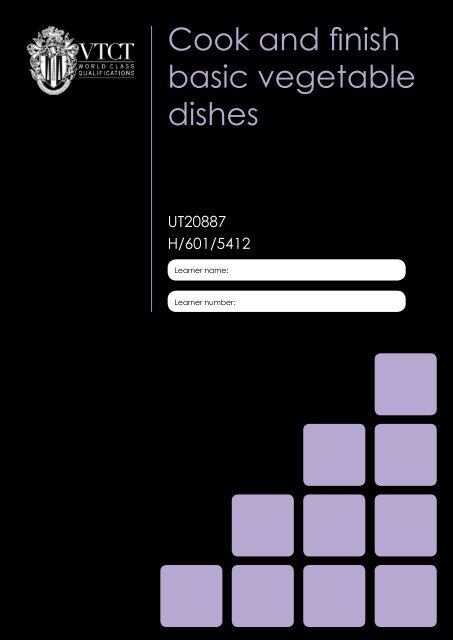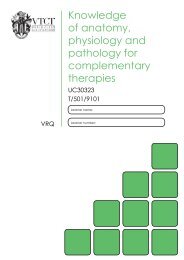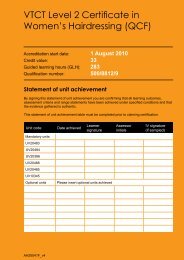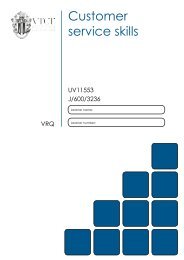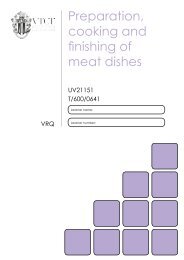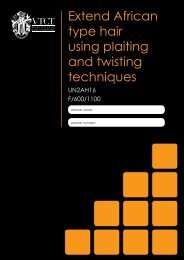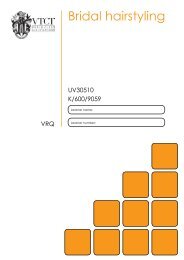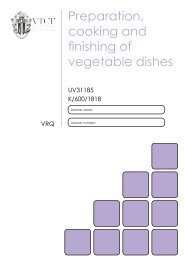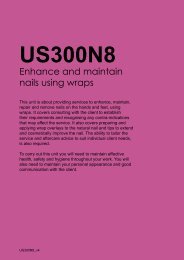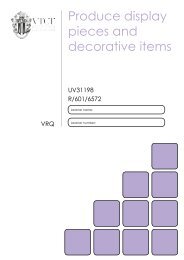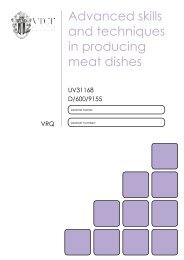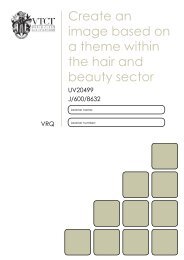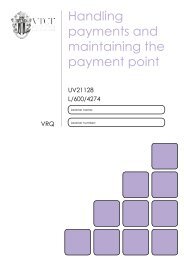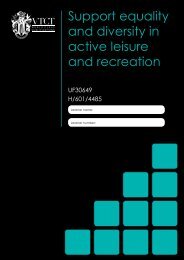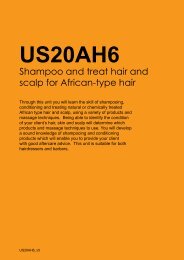Cook and finish basic vegetable dishes - VTCT
Cook and finish basic vegetable dishes - VTCT
Cook and finish basic vegetable dishes - VTCT
Create successful ePaper yourself
Turn your PDF publications into a flip-book with our unique Google optimized e-Paper software.
<strong>Cook</strong> <strong>and</strong> <strong>finish</strong><br />
<strong>basic</strong> <strong>vegetable</strong><br />
<strong>dishes</strong><br />
UT20887<br />
H/601/5412<br />
Learner name:<br />
Learner number:
Statement of unit achievement<br />
By signing this statement of unit achievement you are confirming that all learning outcomes, assessment<br />
criteria <strong>and</strong> range statements have been achieved under specified conditions <strong>and</strong> that the evidence<br />
gathered is authentic.<br />
This statement of unit achievement table must be completed prior to claiming certification.<br />
Unit code Date achieved Learner signature<br />
Assessor tracking table<br />
<strong>VTCT</strong> is the specialist awarding body for the Hairdressing, Beauty Therapy, Complementary Therapy,<br />
Hospitality <strong>and</strong> Catering <strong>and</strong> Sport <strong>and</strong> Active Leisure sectors, with over 45 years of experience.<br />
<strong>VTCT</strong> is an awarding body regulated by national organisations including Ofqual, SQA, DfES <strong>and</strong> CCEA.<br />
<strong>VTCT</strong> is a registered charity investing in education <strong>and</strong> skills but also giving to good causes in the area<br />
of facial disfigurement.<br />
Assessor name Assessor signature<br />
Assessor<br />
initials<br />
Assessors<br />
initials<br />
IV signature<br />
(if sampled)<br />
All assessors using this Record of Assessment book must complete this table. This is required for<br />
verification purposes.<br />
Assessor number<br />
(optional)
UT20887<br />
<strong>Cook</strong> <strong>and</strong> <strong>finish</strong> <strong>basic</strong> <strong>vegetable</strong><br />
<strong>dishes</strong><br />
The aim of this unit is to develop your knowledge,<br />
underst<strong>and</strong>ing <strong>and</strong> practical skills in cooking <strong>and</strong> <strong>finish</strong>ing<br />
<strong>basic</strong> <strong>vegetable</strong> <strong>dishes</strong>, for example, <strong>vegetable</strong> curry,<br />
roasted <strong>vegetable</strong>s, stuffed <strong>vegetable</strong>s, spring rolls,<br />
samosas <strong>and</strong> pakora(s).<br />
UT20887_v9
NOS<br />
2FC7<br />
Level<br />
Credit value<br />
GLH<br />
2<br />
4<br />
32<br />
Observation(s)<br />
2<br />
External paper(s)<br />
0
<strong>Cook</strong> <strong>and</strong> <strong>finish</strong> <strong>basic</strong> <strong>vegetable</strong><br />
<strong>dishes</strong><br />
Learning outcomes<br />
On completion of this unit you will:<br />
1. Be able to cook <strong>basic</strong> <strong>vegetable</strong> <strong>dishes</strong><br />
2. Be able to <strong>finish</strong> <strong>basic</strong> <strong>vegetable</strong> <strong>dishes</strong><br />
3. Underst<strong>and</strong> how to cook <strong>basic</strong> <strong>vegetable</strong><br />
<strong>dishes</strong><br />
4. Underst<strong>and</strong> how to <strong>finish</strong> <strong>basic</strong> <strong>vegetable</strong><br />
<strong>dishes</strong><br />
Evidence requirements<br />
1. Environment<br />
Evidence for this unit should be gathered<br />
within the workplace, however, you may<br />
be assessed within an approved realistic<br />
working environment (RWE) that meets<br />
People 1st’s criteria.<br />
2. Simulation<br />
Simulation is not allowed in this unit.<br />
3. Observation outcomes<br />
Competent performance of Observation<br />
outcomes must be demonstrated on<br />
at least two occasions. Assessor<br />
observations, witness testimonies <strong>and</strong><br />
products of work are likely to be the most<br />
appropriate sources of performance<br />
evidence. Professional discussion may be<br />
used as supplementary evidence for those<br />
criteria that do not naturally occur.<br />
Assessed observations should not be<br />
carried out on the same day for the<br />
same learning outcome. There should be<br />
sufficient time between assessments for<br />
reflection <strong>and</strong> personal development.<br />
You need to meet the same st<strong>and</strong>ard on a<br />
regular <strong>and</strong> consistent basis. Separating<br />
the assessments by a period of at least two<br />
weeks is recommended as competence<br />
must be demonstrated on a consistent <strong>and</strong><br />
regular basis.<br />
4. Range<br />
All ranges must be competently<br />
demonstrated as part of an assessed<br />
observation.<br />
5. Knowledge outcomes<br />
There must be evidence that you possess<br />
all the knowledge <strong>and</strong> underst<strong>and</strong>ing<br />
listed in the Knowledge section of this<br />
unit. In most cases this can be done<br />
by professional discussion <strong>and</strong>/or oral<br />
questioning. Other methods, such as<br />
projects, assignments <strong>and</strong>/or reflective<br />
accounts may also be used.<br />
6. Tutor/Assessor guidance<br />
You will be guided by your tutor/assessor<br />
on how to achieve learning outcomes <strong>and</strong><br />
cover ranges in this unit. All outcomes <strong>and</strong><br />
ranges must be achieved.<br />
7. External paper<br />
There is no external paper for this unit.<br />
UT20887<br />
3
4<br />
Achieving observations<br />
<strong>and</strong> range<br />
Achieving observation outcomes<br />
Your assessor will observe your performance<br />
of practical tasks. The minimum number of<br />
competent observations required is indicated in<br />
the Evidence requirements section of this unit.<br />
Criteria may not always naturally occur during<br />
a practical observation. In such instances you<br />
will be asked questions to demonstrate your<br />
competence in this area. Your assessor will<br />
document the criteria that have been achieved<br />
through professional discussion <strong>and</strong>/or oral<br />
questioning. This evidence will be recorded<br />
by your assessor in written form or by other<br />
appropriate means.<br />
Your assessor will sign off a learning outcome<br />
when all criteria have been competently<br />
achieved.<br />
Achieving range<br />
The range section indicates what must be<br />
covered. The specified number of ranges<br />
must be practically demonstrated as part of<br />
an assessed observation. Evidence for the<br />
remaining points under the range must be<br />
assessed through questioning or witness<br />
testimony.<br />
Every range item must be evidenced.<br />
You may be required to undertake additional<br />
observations to ensure all range items have<br />
been covered. <strong>VTCT</strong> recommends that where<br />
possible all ranges are covered practically. Your<br />
assessor will document the portfolio reference<br />
once a range has been covered.<br />
UT20887<br />
Guidance for tutors <strong>and</strong> assessors<br />
Tutors <strong>and</strong> assessors must refer to the<br />
document(s) listed below, prior to delivering<br />
this unit. Document(s) can be downloaded from<br />
http://www.people1st.co.uk:<br />
• Sector Assessment Strategy for<br />
competence based units of assessment<br />
<strong>and</strong> qualifications
Learning outcome 1<br />
Be able to cook <strong>basic</strong> <strong>vegetable</strong> <strong>dishes</strong><br />
You can:<br />
a. Check <strong>vegetable</strong>s meet dish requirements<br />
b. Choose <strong>and</strong> use tools <strong>and</strong> equipment<br />
correctly<br />
c. Combine <strong>vegetable</strong>s with other ingredients<br />
d. <strong>Cook</strong> <strong>vegetable</strong>s to meet dish requirements<br />
*May be assessed by supplementary evidence.<br />
Observations<br />
Observation 1 2 Optional Optional<br />
Criteria questioned orally<br />
Date achieved<br />
Portfolio reference<br />
Learner signature<br />
Assessor initials<br />
UT20887<br />
5
6<br />
Learning outcome 2<br />
Be able to <strong>finish</strong> <strong>basic</strong> <strong>vegetable</strong> <strong>dishes</strong><br />
You can:<br />
a. Finish the dish to meet requirements<br />
b. Make sure the dish is at the correct<br />
temperature for holding <strong>and</strong> serving**<br />
c. Make sure the dish has the correct colour,<br />
flavour, consistency <strong>and</strong> quantity<br />
d. Safely store any cooked <strong>vegetable</strong>s not for<br />
immediate use*<br />
*May be assessed by supplementary evidence.<br />
**The assessor may assess you through questioning or witness testimony for one of these (i.e.<br />
either holding or serving) but must observe the other.<br />
Observation 1 2 Optional Optional<br />
Criteria questioned orally<br />
Date achieved<br />
Portfolio reference<br />
Learner signature<br />
Assessor initials<br />
UT20887
You must practically demonstrate that you have:<br />
Range<br />
<strong>Cook</strong>ed a minimum of 8 types of <strong>vegetable</strong>s Portfolio reference<br />
Roots<br />
Tubers<br />
Bulbs<br />
Flower heads<br />
Fungi<br />
Seeds <strong>and</strong> pods<br />
Leaves<br />
Stems<br />
Vegetable fruits<br />
Used a minimum of 6 cooking techniques Portfolio reference<br />
Blanching<br />
Boiling<br />
Roasting<br />
Baking<br />
Grilling<br />
Braising<br />
Frying (deep, shallow or stir)<br />
Steaming<br />
Stewing<br />
Combining cooking methods<br />
Where applicable, the specified number of ranges must be practically demonstrated as part of an<br />
observation. Those remaining must be evidenced by practical observation or other assessment<br />
methods. All ranges must be evidenced in your portfolio.<br />
UT20887 7
8<br />
Developing knowledge<br />
Achieving knowledge outcomes<br />
You will be guided by your tutor <strong>and</strong> assessor<br />
on the evidence that needs to be produced.<br />
Your knowledge <strong>and</strong> underst<strong>and</strong>ing will be<br />
assessed using the assessment methods listed<br />
below*:<br />
• Projects<br />
• Observed work<br />
• Witness statements<br />
• Audio-visual media<br />
• Evidence of prior learning or attainment<br />
• Written questions<br />
• Oral questions<br />
• Assignments<br />
• Case studies<br />
• Professional discussion<br />
Where applicable your assessor will integrate<br />
knowledge outcomes into practical observations<br />
through professional discussion <strong>and</strong>/or oral<br />
questioning.<br />
When a criterion has been orally questioned<br />
<strong>and</strong> achieved, your assessor will record this<br />
evidence in written form or by other appropriate<br />
means. There is no need for you to produce<br />
additional evidence as this criterion has already<br />
been achieved.<br />
Some knowledge <strong>and</strong> underst<strong>and</strong>ing outcomes<br />
may require you to show that you know <strong>and</strong><br />
underst<strong>and</strong> how to do something. If you have<br />
practical evidence from your own work that<br />
meets knowledge criteria, then there is no<br />
requirement for you to be questioned again on<br />
the same topic.<br />
*This is not an exhaustive list.<br />
UT20887
Knowledge<br />
Learning outcome 3<br />
Underst<strong>and</strong> how to cook <strong>basic</strong> <strong>vegetable</strong> <strong>dishes</strong><br />
You can: Portfolio reference<br />
a. Describe how to check <strong>vegetable</strong>s meet dish requirements<br />
b. State what quality points to look for in a range of <strong>vegetable</strong>s<br />
c. Describe what to do if there are any problems with <strong>vegetable</strong>s or<br />
other ingredients<br />
d. State the correct tools <strong>and</strong> equipment required to carry out<br />
different cooking methods<br />
e. Describe how to carry out different cooking methods for <strong>vegetable</strong>s<br />
f. State the correct temperatures for cooking different types of<br />
<strong>vegetable</strong>s<br />
g. State the differences between cooking green <strong>vegetable</strong>s <strong>and</strong> root<br />
<strong>vegetable</strong>s<br />
h. Describe how to maintain the nutritional value of <strong>vegetable</strong>s during<br />
cooking<br />
i. State the main reasons for blanching <strong>vegetable</strong>s<br />
j. State which <strong>vegetable</strong>s are suitable for high <strong>and</strong> low pressure<br />
steaming<br />
k. State healthy eating options when cooking <strong>vegetable</strong>s<br />
UT20887 9
10<br />
Learning outcome 4<br />
Underst<strong>and</strong> how to <strong>finish</strong> <strong>basic</strong> <strong>vegetable</strong> <strong>dishes</strong><br />
You can: Portfolio reference<br />
a. Describe how to <strong>finish</strong> <strong>basic</strong> <strong>vegetable</strong> <strong>dishes</strong><br />
b. State the correct temperatures for holding <strong>and</strong> serving <strong>vegetable</strong><br />
<strong>dishes</strong><br />
c. State healthy eating options when <strong>finish</strong>ing <strong>vegetable</strong> <strong>dishes</strong><br />
UT20887


